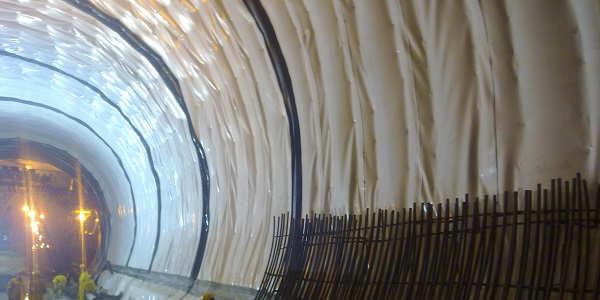Tunnel insulation (tunnel sealing)
Protection of underground structures such as tunnels is essential due to soil conditions, groundwater, facilities used, and the efficiency of the underground structure. Many parameters are involved in the design of the tunnel sealing system.

These parameters are a function of the type of underground structure use:
Type of structural system
Structure placement depth (lowest structural depth)
Highest groundwater level after construction
Environmental conditions such as pH of water, hydrocarbons, chemicals
Ease of installation
Construction cost
Long-term maintenance (taking into account costs)
Tunnel sealing system can be done both internally and externally. The safest and most engineered type of sealing is the exterior of the tunnel. The reason for this is that in this method, water and moisture do not reach the concrete and further problems including corrosion of reinforcements and will be avoided.
Sealing the inside of the tunnel is usually done when the tunnel is being repaired and repaired because the exterior of the tunnel is not available in these conditions.
Tunnel Sealing Methods – Tunnel Isolation
Resin injection
Advantages of using this method:
Proper insulation performance
Ability to cover all types of seams and cracks
High execution speed
High durability
Possibility of execution on the inside and outside of concrete
Prevent corrosion of steel
Disadvantages:
Expert and skilled force
Sophisticated machines
Sealing with liquid insulation
Advantages:
Completely sticky
Permeable inside cracks
Can be installed on horizontal pages
Create an integrated and seamless environment
Disadvantages:
Low length increase (usually less than 50%)
Requires installation equipment
Vulnerable to hydrocarbon attacks
Requires a surface under dry work
Unsuitable for vertical surfaces
It does not repair itself
Requires formatting
Tunnel sealing with the help of panel insulation
Advantages of using bentonite plates:
Resistant to hydrocarbon attacks
Quick installation
Smooth and convenient surface
Disadvantages:
Requires drilling holes during installation
No swelling in salt water
The seams are difficult to seal
Abundant seams and cracks
Rigid system with no change in length
Tunnel sealing with the help of geomembranes
Advantages of geomembranes:
Quick and easy installation
Resistant to hydrocarbon attacks
Low seams and cracks
Very suitable for tunnels with manual drilling and connection shafts
Ability to separate the torn part
Suitable for high hydrostatic pressure
Very resistant in connection areas
200 to 300% long length change
Tunnel sealing with the help of epoxy coating system
:Advantages of epoxy coating system
No need for formatting
Relatively easy to implement
Seamless and crack
Disadvantages:
Toxic fumes
Low flash point
Rigid system: no change in length
It has no self-healing properties
The surface under the work must be clean and dry



